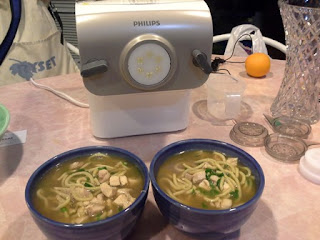Philips Pasta maker review HR2357-06
Figure 1. Phillips pasta maker and udon soup with udon noodles made from the pasta maker
Summary (two years of use)
- Excellent performance
- A wide variety of pasta dyes
- Pasta in 15 min
- 30g of waste dough - can be easily rolled into pasta (extra 10 min)
- Plastic lid can break if dropped (be careful)
Background
I made fresh pasta a few occasions with the hand roller machine. It was great, I liked the softer textured fresh pasta. This process was very messy and time-consuming, so it was only done occasionally. I am also trying to eat healthier and learnt about the poor quality of products made from white flour (its a next step away from sugar) and the better quality of wholegrain flour (not wholemeal flour, there is a difference). Pasta is made from hard durum semolina wheat and is healthy in the context that it breaks down slowly in the stomach to reduce the sugar blood spike (semolina durum flour is like fine grains of sand and takes time to break down). However I wanted to make a pasta with a mix of whole grain flour and durum wheat to get a bit more fibre and wheat germ into my families diet, the only way do this is to make my own pasta.Then I read about the Phillips pasta maker, checked out the reviews, most were positive, and then it came on special and in May 2016 I decided to buy it.
Pasta performance and quality
For both criteria, I rate it as excellent, one of the best kitchen appliances I have purchased. Its strong, sturdy and does what it is meant to do. Most of all we love the pasta!Purchase considerations
Cost and quality: There are cheaper machines, my friend has one and it has a poor build quality and a limited number of dyes It broke down eventually. Pushing dough through a small hole generates considerable pressure so the machine needs to be strong enough both in motor and body structure to handle the workload. If your not sure about if pasta making is "your thing", then perhaps buy a very cheap machine and see if you like making your own pasta, if so then get the proper machine and give the old one to a friend (if it's still working) for them to try it out.Weight: It's a heavy machine, but not too heavy for the average man or woman to pull out of a cupboard (I get the job of doing it and happily do it in the knowledge of what I get out of it).
Combo scales option: I bought the machine without scales incorporated into it. I am happy weighing out the flour in a plastic container and kitchen scales. I often throw in too much flour into the container and have to take some out, I am not sure how easy it might be to take out of the machine flour container.
Flour
Traditional pasta is made from durum semolina flour. Australia grows one of the best quality wheat in the world and you can purchase durum semolina wheat. I am not a flour expert but from what I have been able to understand "semolina" simply means the starchy part of the grain. You can buy semolina flour from different types of wheat. Pasta is made from durum wheat, so we want the semolina of durum wheat, this flour is a light yellow colour and feels like fine sand. I have bought white semolina flour, it still made good pasta but I do not know where it came from and its nutritional characteristics. I eventually purchased durum semolina from a food wholesaler shop in my hometown, they could only order in a 25 kg bag (on years supply). The flour manufacturer is Manildra (http://www.manildra.com.au/). The website indicates 12.5 kg bags are available.I make a mix of 50% durum semolina and 50% wholegrain flour. I will discuss the wholegrain flour in a separate blog.
You can use normal white flour. Some Asian noodles require white flour, we do make Hokkien noodles for stir-fries. We use a 50-50 mix of wholegrain and white in these situations. The noodles are not the same rubbery feel as the one in the supermarket packets, but good enough. We do add a bit of lye water (potassium bicarbonate) in the Asian noodle recipe to help make them a bit more rubbery. We find 100% wholegrain flour has a too strong "wheat" flavour and thus a 50-50 mix suits us, maybe after we get more use to wholegrain flour we can substitute more white for wholegrain flour.
Cleaning
It is easy to remove the plastic mixing container and dyes for cleaning. Cleaning the dyes full of dough is tricky, but easy once with the following technique. Straight after using the machine I like to remove the residual dough from the dye immediately with a wooden barbeque (BBQ) skewer, then roll and cut it into pasta (reduce food waste). this cleans out 95% of the dough from the dye. There is a little remaining in the dye holes, I let the residual pasta in the holes of the dye dry (duration of dinner) and then when washing up time comes I pop out the dry pasta from the holes with the BBQ skewer (its also kind of fun, the kids love doing it!)Warning: The clear plastic lid and mixing container is made from brittle plastic and will easily break if it falls onto a tile floor.

Comments
Post a Comment